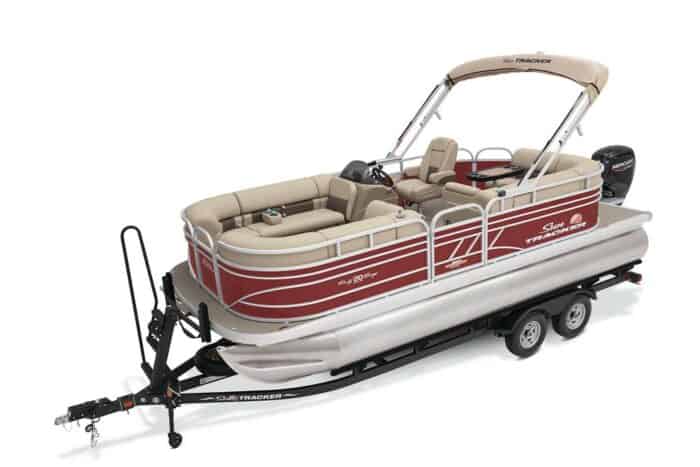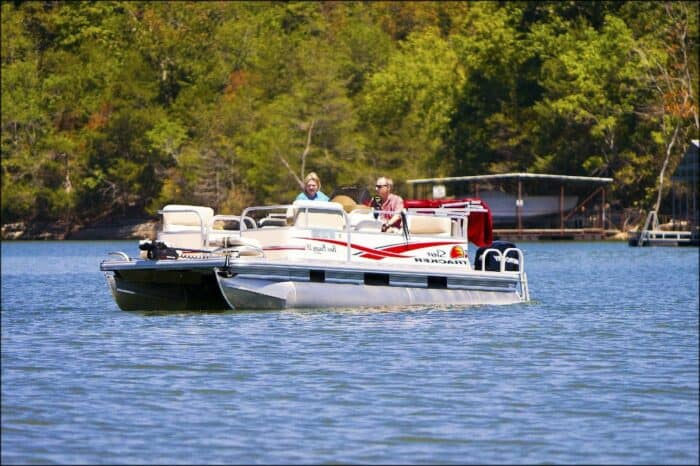How Wide is a Pontoon Boat? Everything You Need To Know
There’s no set width for pontoon boats because how could there be? Boat width is generally determined by the construction and design of the boat and what width allows it to be most efficient in operation. That said, pontoons often give more deck space than other boats and can be wider as a result. Functional width of a pontoon boat depends on the length of the boat as well. A small pontoon boat may have a width of as little as 7 feet across while the largest pontoons can reach a width of over 12 feet but that would be exceedingly rare. Most pontoons will have a width somewhere between 8 and 10 feet, however.
It’s possible for both smaller and larger to exist. Larger would likely be a custom job as there are maybe only one or two models that are manufactured anywhere currently over 12 feet. I can’t recall ever seeing anything wider than a 12 foot pontoon boat in real life. Smaller would indicate a mini or compact pontoon boat and these are generally just fishing vessels for one.
Why Are Pontoon Boats Wider Than Other Boats?
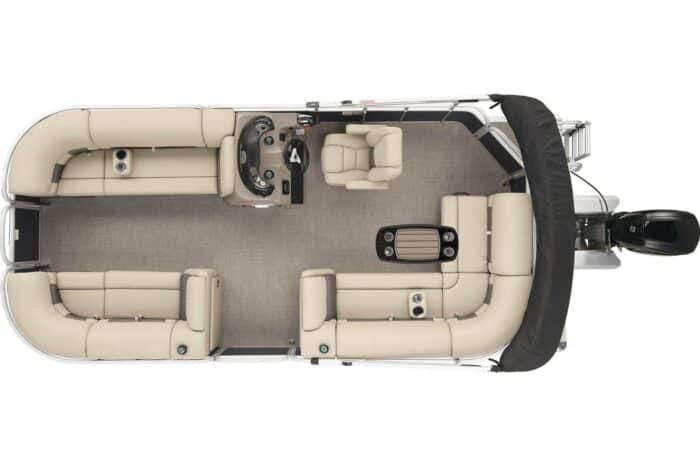
The width of a pontoon boat is actually one of the most prized selling features of this style of boat compared to others. It’s not even technically that the boat is wider than another boat with a traditional hull, it’s that a pontoon makes the space more usable. That being said, pontoons can and will often also be slightly wider than traditionally hulled vessels of the same length, which makes the extra space that much more noticeable.
Because of how pontoon boats are built and how they maintain buoyancy on those pontoon logs, the entire deck space can be functional on a pontoon, while it needs to be more limited on vessels with v-shaped hulls in order to maximize buoyancy and stability.
Since the flat deck is elevated there are no constraints to how that deck space can be used so you’ll average more square footage on a pontoon boat than you would on a more traditional boat, even if they are exactly the same length.
Factors that Affect Pontoon Boat Width
There are two ways to consider the width of a pontoon boat. There’s actual width and functional width and the purpose of the boat will have an effect on that.
Actual width is pretty obvious and easy to understand, it’s just the width from one edge of the boat to the opposite one. This is relevant information for transporting and trailing the boat, storing the boat, and docking and maneuvering.
Functional width covers the width on deck you can use and that often depends on the type or purpose of your pontoon. A Party Barge, for instance, may have port and starboard couches for passengers to sit on which can take up a large portion of the deck and make the rest of the usable space narrow.
A very simple fishing pontoon may have pedestal seats and almost no other amenities – some don’t even have railings. In those cases, the width is all usable or empty space. A boat like this will not need to be as wide as a party boat because it’s only designed for a single purpose with limited passengers.
So long as the vessel is still functional and user friendly, a manufacturer can make it wider or narrower as they see fit. There’s no specific rule for how wide any boat has to be within reason and beyond the science of what is necessary to keep it balanced and floating, of course. That’s why you’ll often find a range from one pontoon brand to another. Some boats may have an extra couple of inches of width and even up to a foot or more depending on the boat’s intended purpose and how they construct their vessels.
Benefits of a Wide Pontoon Boat
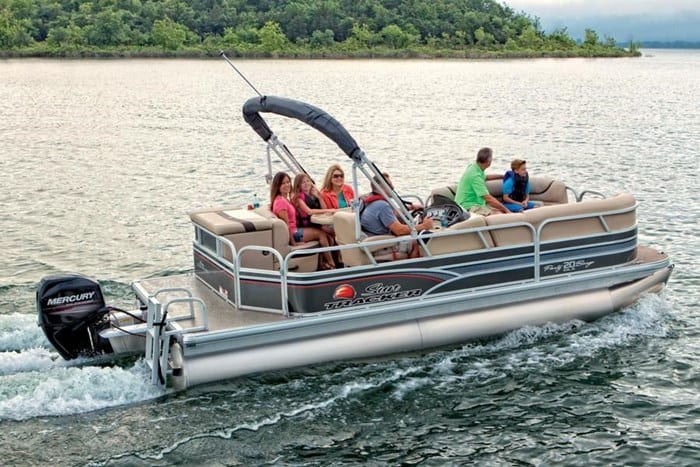
The width of a pontoon has a couple of benefits for you as a boater. First and foremost, and one of the reasons pontoons are so popular, is stability and smoothness. People who have trouble getting their sea legs on other boats often find it a lot easier to adapt to a pontoon boat’s deck. The design is steady and even compared to many other types of boats, at least on still waters and that’s a perk for a lot of people.
Obviously another benefit of the extra space is you can do more with it. That’s why pontoon boats are sold as recreational or party boats very often. More usable deck space means more passengers or gear that you can use for fun. A 20 foot long pontoon that is between 8 and 9 feet wide can potentially accommodate 8 to 10 passengers plus gear and ensure comfort.
If you want to do a lot of fishing on a pontoon you may not feel you need as much width, but there’s something to be said for the increased storage, not to mention space to maneuver around if you have more than one angler on board. The stable platform is preferred by some anglers as well because it’s more like fishing from shore or on a dock than fishing from a traditional boat.
Are There Drawbacks to Wide Pontoon Boat Dimensions?
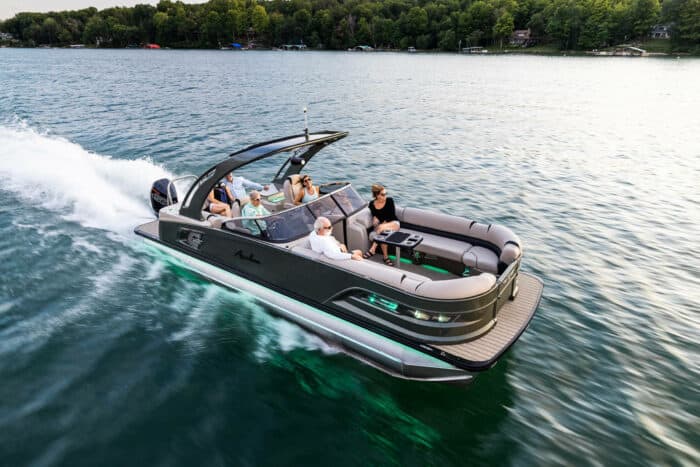
In general, most of us are never going to be trying to pilot a pontoon that’s so wide it’s hard to navigate in certain waterways or anything of that nature. That said, as with any boat that increases in size, there are increased issues that come along with it. In this case you’d need to be most aware of two:
- Cost
- Transportability
The bigger, and wider, the pontoon, the more it’s going to cost you. Not a surprise, to be sure but take note that width does tend to cost more than length. You can usually buy boats that are the same width as they increase in length. But when the width does increase at a certain size, the price increase is typically much larger and the overall effect, to most people’s eyes, is of little difference.
When people ask what size your boat is, you’ll usually just say the length and that’s the metric most of us pay attention to. Width increases are harder to notice and they will cost more, so keep that in mind.
Transportation can become more difficult with wider boaters as well which is why some small pontoon boats will still remain more popular. At a certain size a boat is obviously no longer trailerable, but even before that just a little bit of extra width can add considerable weight to an entire boat. That means a trailer upgrade may be in order to handle the extra weight. Storage accommodations may be needed as well.
How Does a Pontoon’s Width Affect Performance?
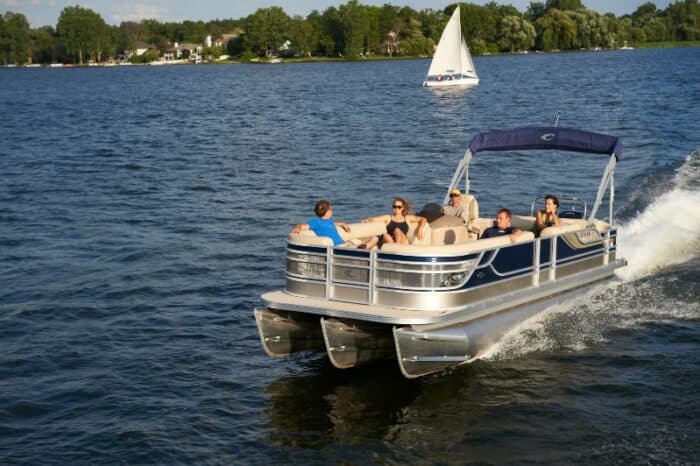
Width affects the overall performance of a pontoon in a few ways. To start with, a wider boat will probably mean a longer boat and a more stable boat on the water. It may seem counterintuitive to say this but a wider boat will probably be faster on the water, provided you’re using the right motor for the boat’s size and you’re paying attention to weight limits. The extra stability along with engine power ensures a smoother, faster ride. Keep in mind, however, that few pontoons are built for speed in the first place. A fast pontoon is usually not as fast as a fast v-hull of the same length.
The downside to this is that, the larger the engine and the larger the boat, the more your fuel efficiency suffers. So you’re going to get less out of the engine with a wider boat and you’re going to pay a little more for it. That’s pretty much par for the course with larger boats and larger engines, however, so it shouldn’t come as a surprise.
In addition to speed a wider pontoon is, as we mentioned before, more stable. Pontoons are not as good on rough waters as a v-hull so a wider stance in the water allows them to deal with waves and chop a little better.
Finally, maneuverability with a wider pontoon may actually be easier than you’d think. Pontoon boats generally handle well. A large pontoon boat width and a more stable base means that driving the boat is often simpler than may boaters, especially first timers, realize.
The Bottom Line
The width of a pontoon boat is not a number that is set in stone. The standard pontoon boat width seems to be about 8 feet to maybe 8 and a half feet. You can find some rare instances of small pontoon boat sizes and there are also larger pontoons with more width as well. Mini pontoon boats or compact pontoon boats can get much smaller but these are usually harder to find and are classified differently.
As with most boats, as the pontoon boat length increases, the wider it will get, so large pontoon boats over 30 feet are more likely to be 10 feet wide or more, but these boats are less common. Pontoon boats weigh more at this size as well, obviously.
Width on an average pontoon boat offers a number of benefits including speed and performance as well as comfort and simply space for more people and more gear on board. The drawbacks, however, can come in the form of a much bigger initial investment for a wider boat, and more difficulty in transporting and storing a larger vessel.
Categories: Pontoon Boats
